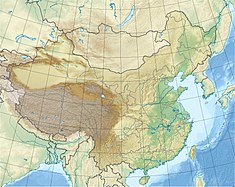Gezhouba Dam
| Gezhouba Dam | |
|---|---|

The Gezhouba Dam site
|
|
|
Location of Gezhouba Dam in China
|
|
| Location | Yichang, China |
| Coordinates | 30°44′23″N 111°16′20″E / 30.73972°N 111.27222°ECoordinates: 30°44′23″N 111°16′20″E / 30.73972°N 111.27222°E |
| Dam and spillways | |
| Impounds | Yangtze River |
| Height | 47 m (154 ft) |
| Length | 2,595 m (8,514 ft) |
| Reservoir | |
| Total capacity | 1.58 km3 (1,280,000 acre·ft) |
| Power station | |
| Operator(s) | China Yangtze Power |
| Installed capacity | 2,715 MW |
| Annual generation | 14,100 GWh |
The Gezhouba Dam or Gezhouba Water Control Project (Chinese: 长江葛洲坝水利枢纽工程 pinyin: chángjiāng gězhōubà shuǐlì shūniǔ gōngchéng) on the Yangtze River is located in the western suburbs of Yichang City in central China's Hubei province. The dam sits a few kilometers upstream from downtown Yichang, just downstream of the fall of the Huangbo River into the Yangtze. Construction started on December 30, 1970 and ended on December 10, 1988. The dam has a total installed electrical capacity of 2,715 MW.
After rushing out of Nanjin Pass (南津关, "South Ford Pass"), the Yangtze River slows down and widens from 300 metres (980 ft) to about 2,200 metres (7,200 ft) at the dam site. Two small islands, Gezhouba and Xiba, divided the river into three channels. There the Gezhouba Project was built.
The facility boasts a generating capacity of 2.71 GW along with three ship locks, two power stations that generate 14,100 GWh of electricity annually, the 27 gates of the spillway, and the no flowing Dam on both banks. The dam is 2,595 metres (8,514 ft) long with a maximum height of 47 metres (154 ft). The reservoir has a total volume of 1.58 cubic kilometres (1,280,000 acre·ft).
The navigation lock No.2 on the third channel was, when built, among the 100 largest in the world. The lock chamber is 280 metres (920 ft) long and 34 metres (112 ft) wide, with a minimum draft of 5 metres (16 ft) at the sill. It provides passage for 10,000 ton ships.
The construction of the Gezhouba Dam, and others on the Yangtze, is considered by scientists to be the cause of the decline and probable extinction of the Chinese paddlefish.
...
Wikipedia

